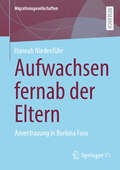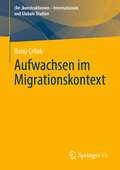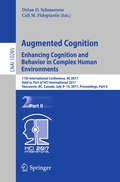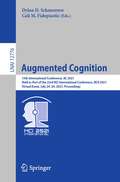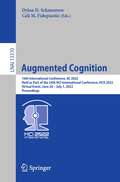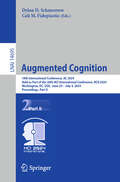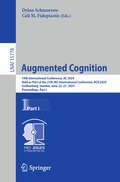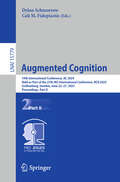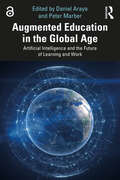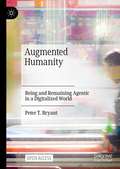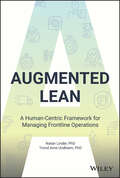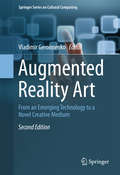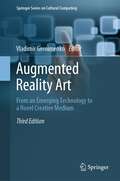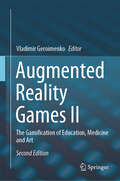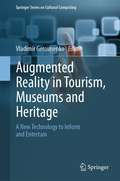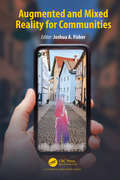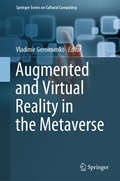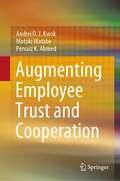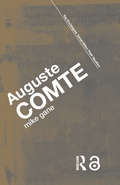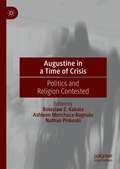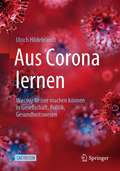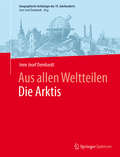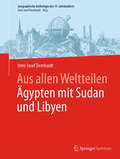- Table View
- List View
Aufwachsen fernab der Eltern: Anvertrauung in Burkina Faso (Migrationsgesellschaften)
by Hannah NiedenführIn Burkina Faso stellt Migration den gesellschaftlichen Normalfall dar. Auch Kinder migrieren im Rahmen ihrer Anvertrauung, einer sozialen Praxis, bei der Kinder bei anderen als ihren leiblichen Eltern aufwachsen. In diesem Buch wird untersucht, warum und auf welche Weise die Anvertrauung praktiziert wird. Vergleichend werden dabei zwei Formen der Anvertrauung gegenübergestellt: die traditionelle Anvertrauung an Verwandte und Bekannte und die religiöse Anvertrauung an Koranlehrer. Unter Beachtung einer insgesamt hohen gesellschaftlichen Vulnerabilität werden die Funktionen der beiden Formen der Anvertrauung für die beteiligten Personen und die Gesellschaft als Ganzes untersucht. Ebenso wird analysiert, welche institutionellen und zivilgesellschaftlichen Akteure im Rahmen der Prozesse des gesellschaftlichen Aushandelns der Anvertrauung in welcher Weise zur Beibehaltung, Änderung oder Bekämpfung dieser sozialen Praxis beitragen und welche Positionierungen, Handlungen und Prozesse ineinandergreifen, die sich bedingen, parallel oder auch konträr zueinander verlaufen.
Aufwachsen im Migrationskontext ((Re-)konstruktionen - Internationale und Globale Studien)
by Banu ÇıtlakDie Bedingungen des Aufwachsens im Migrationskontext sind in Deutschland sowohl in Wissenschaft als auch in der Praxis durch eine ethnozentrische Außensicht geprägt. Daher ist die Bewertung familiärer Verbundenheit, sozialer Mobilität, sozialräumlicher Realität und muslimischer Religiosität kritisch zu hinterfragen. Der Band untersucht die familiäre Verbundenheit als begründete Reaktion auf die Lebenswirklichkeit von Migrationsfamilien, die soziale Mobilität vom „Bildungsaufstieg“ isoliert und ihr die transnational aufgespannte familiäre Anerkennungsstruktur entgegenhält. Enttarnt wird die sozialräumliche Segregation als konstruierte Wirklichkeit. Dieser Konstruktion setzt die Autorin durch ein „Doing-Plural-Communities“ ein Konzept der gelebten Diversität entgegen.
Augmented Cognition. Enhancing Cognition and Behavior in Complex Human Environments: 11th International Conference, AC 2017, Held as Part of HCI International 2017, Vancouver, BC, Canada, July 9-14, 2017, Proceedings, Part II (Lecture Notes in Computer Science #10285)
by Dylan D. Schmorrow Cali M. FidopiastisThis volume constitutes the proceedings of the 11th International Conference on Augmented Cognition, AC 2017, held as part of the International Conference on Human-Computer Interaction, HCII 2017, which took place in Vancouver, BC, Canada, in July 2017. HCII 2017 received a total of 4340 submissions, of which 1228 papers were accepted for publication after a careful reviewing process. The papers thoroughly cover the entire field of Human-Computer Interaction, addressing major advances in knowledge and effective use of computers in a variety of application areas. The two volumes set of AC 2017 presents 81 papers which are organized in the following topical sections: electroencephalography and brain activity measurement, eye tracking in augmented cognition, physiological measuring and bio-sensing, machine learning in augmented cognition, cognitive load and performance, adaptive learning systems, brain-computer interfaces, human cognition and behavior in complex tasks and environments.
Augmented Cognition: 15th International Conference, AC 2021, Held as Part of the 23rd HCI International Conference, HCII 2021, Virtual Event, July 24–29, 2021, Proceedings (Lecture Notes in Computer Science #12776)
by Dylan D. Schmorrow Cali M. FidopiastisThis book constitutes the proceedings of the 15th International Conference on Augmented Cognition, AC 2021, held as part of the 23rd International Conference, HCI International 2020, held as a virtual event, in July 2021. The total of 1276 papers and 241 posters included in the 36 HCII 2021 proceedings volumes was carefully reviewed and selected from 5222 submissions.AC 2021 includes a total of 32 regular papers; they were organized in topical sections named: BCI and brain activity measurement physiological measuring and human performance; modelling human cognition; and augmented cognition in complex environments.
Augmented Cognition: 16th International Conference, AC 2022, Held as Part of the 24th HCI International Conference, HCII 2022, Virtual Event, June 26 – July 1, 2022, Proceedings (Lecture Notes in Computer Science #13310)
by Dylan D. Schmorrow Cali M. FidopiastisThis book constitutes the refereed proceedings of the 16th International Conference on Augmented Cognition, AC 2022, held as part of the 23rd International Conference, HCI International 2022, which was held virtually in June/July 2022.The total of 1271 papers and 275 posters included in the HCII 2022 proceedings was carefully reviewed and selected from 5487 submissions. The AC 2022 proceedings aims to develop adaptive systems capable of extending the information management capacity of individuals through computing technologies and offers a broad range of theoretical and applied issues related to Augmented Cognition and its applications.
Augmented Cognition: 18th International Conference, AC 2024, Held as Part of the 26th HCI International Conference, HCII 2024, Washington, DC, USA, June 29–July 4, 2024, Proceedings, Part I (Lecture Notes in Computer Science #14694)
by Dylan D. Schmorrow Cali M. FidopiastisThis book constitutes the refereed proceedings of the 18th International Conference on Augmented Cognition, AC 2024, held as part of the 26th HCI International Conference, HCII 2024, which took place in Washington, DC, USA, during June 29–July 4, 2024. The total of 1271 papers and 309 posters included in the HCII 2024 proceedings was carefully reviewed and selected from 5108 submissions. The AC 2024 proceedings were organized in the following topical sections: Part I: Understanding cognitive processes and human performance; advancing cognitive abilities and performance with augmented tools; Part II: Advances in augmented cognition technologies; applications of augmented cognition in various contexts.
Augmented Cognition: 18th International Conference, AC 2024, Held as Part of the 26th HCI International Conference, HCII 2024, Washington, DC, USA, June 29–July 4, 2024, Proceedings, Part II (Lecture Notes in Computer Science #14695)
by Dylan D. Schmorrow Cali M. FidopiastisThis book constitutes the refereed proceedings of the 18th International Conference on Augmented Cognition, AC 2024, held as part of the 26th HCI International Conference, HCII 2024, which took place in Washington, DC, USA, during June 29–July 4, 2024. The total of 1271 papers and 309 posters included in the HCII 2024 proceedings was carefully reviewed and selected from 5108 submissions. The AC 2024 proceedings were organized in the following topical sections: Part I: Understanding cognitive processes and human performance; advancing cognitive abilities and performance with augmented tools; Part II: Advances in augmented cognition technologies; applications of augmented cognition in various contexts.
Augmented Cognition: 19th International Conference, AC 2025, Held as Part of the 27th HCI International Conference, HCII 2025, Gothenburg, Sweden, June 22–27, 2025, Proceedings, Part I (Lecture Notes in Computer Science #15778)
by Dylan D. Schmorrow Cali M. FidopiastisThe two volume set LNAI 15778 and LNAI 15779 constitutes the refereed proceedings of the 19th International Conference on Augmented Cognition, AC 2025, held as part of the 27th HCI International Conference, HCII 2025, which took place in Gothenburg, Sweden, June 22–27, 2025. The total of 1430 papers and 355 posters included in the HCII 2025 proceedings was carefully reviewed and selected from 7972 submissions. The papers have been organized in topical sections as follows: Part I: Neurotechnology and eye tracking in augmented cognition; augmented cognitiona dn user experience; Part II: Emotions in augmented cognition; enhancing learning and memory.
Augmented Cognition: 19th International Conference, AC 2025, Held as Part of the 27th HCI International Conference, HCII 2025, Gothenburg, Sweden, June 22–27, 2025, Proceedings, Part II (Lecture Notes in Computer Science #15779)
by Dylan D. Schmorrow Cali M. FidopiastisThe two volume set LNAI 15778 and LNAI 15779 constitutes the refereed proceedings of the 19th International Conference on Augmented Cognition, AC 2025, held as part of the 27th HCI International Conference, HCII 2025, which took place in Gothenburg, Sweden, June 22–27, 2025. The total of 1430 papers and 355 posters included in the HCII 2025 proceedings was carefully reviewed and selected from 7972 submissions. The papers have been organized in topical sections as follows: Part I: Neurotechnology and eye tracking in augmented cognition; augmented cognitiona dn user experience; Part II: Emotions in augmented cognition; enhancing learning and memory.
Augmented Education in the Global Age: Artificial Intelligence and the Future of Learning and Work
by Peter Marber Daniel ArayaAugmented Education in the Global Age: Artificial Intelligence and the Future of Learning and Work is an edited collection that explores the social impact of Artificial Intelligence over the coming decades, specifically how this emerging technology will transform and disrupt our contemporary institutions. Chapters in this book discuss the history of technological revolutions and consider the anxieties and social challenges of lost occupations, as well as the evolution of new industries overlapping robotics, biotechnology, space exploration, and clean energy. Chapter authors unpack the nature of augmented education, from revamping curriculum and personalizing education, to redesigning workplace learning for an algorithmic era. Ultimately the book discusses policy and planning for an augmented future, arguing that work and learning are undergoing a metamorphosis around creativity and innovation amid a new global era and the race against automating technologies. Bringing together expert perspectives from around the world, this exciting, informative collection of research and analysis helps educators, policymakers and analysts navigate the future of work and learning amid rapid and accelerating technological change. The Open Access version of this book, available at http://www.taylorfrancis.com, has been made available under a Creative Commons Attribution-Non Commercial-No Derivatives (CC-BY-NC-ND) 4.0 license.
Augmented Human: How Technology Is Shaping the New Reality
by Helen PapagiannisAugmented Reality (AR) blurs the boundary between the physical and digital worlds. In AR’s current exploration phase, innovators are beginning to create compelling and contextually rich applications that enhance a user’s everyday experiences. In this book, Dr. Helen Papagiannis—a world-leading expert in the field—introduces you to AR: how it’s evolving, where the opportunities are, and where it’s headed.If you’re a designer, developer, entrepreneur, student, educator, business leader, artist, or simply curious about AR’s possibilities, this insightful guide explains how you can become involved with an exciting, fast-moving technology.You’ll explore how:Computer vision, machine learning, cameras, sensors, and wearables change the way you see the worldHaptic technology syncs what you see with how something feelsAugmented sound and hearables alter the way you listen to your environmentDigital smell and taste augment the way you share and receive informationNew approaches to storytelling immerse and engage users more deeplyUsers can augment their bodies with electronic textiles, embedded technology, and brain-controlled interfacesHuman avatars can learn our behaviors and act on our behalf
Augmented Humanity: Being and Remaining Agentic in a Digitalized World
by Peter T. BryantThis open access book will examine the implications of digitalization for the understanding of humanity, conceived as a community of intelligent agency. It addresses important topics across a range of social and behavioral theories and identifies a range of novel mechanisms and their social behavioral effects. Across the book, the author highlights the expansion of intelligent processing capability brought about by digitalization and the challenges this exposes for integrating artificial and human capabilities. It includes the altered effects of bounded rationality in problem solving and decision making; related changes in the perception of rationality, plus novel myopias and biases. It also seeks to address cognitive intersubjectivity, learning from performance and agentic self-generation; and the novel methods and patterns of reasoned thought which emerge in a digitalized world; and how these mechanisms will combine in making and remaking the world of human experience and understanding. This book examines the problematics and prospects for digitally augmented humanity. In doing so, it maps the terrain for a future science of augmented agency. It will have cross-disciplinary appeal to students and scholars of applied psychology, cognitive and behavioral science, organizational psychology and management, business, finance, and digital cultures and humanities.
Augmented Lean: A Human-Centric Framework for Managing Frontline Operations
by Trond Arne Undheim Natan LinderExplore the real future of work in this expert tech implementation guide that goes beyond automation In Augmented Lean: A Human-Centric Framework for Managing Frontline Operations, serial startup founder Dr. Natan Linder and futurist podcaster Dr. Trond Arne Undheim deliver an urgent and incisive exploration of how to facilitate agile processes amongst a millennial workforce that already lives by many of its tenets. The book demonstrates how to abandon legacy industrial technology that is failing modern operations and hindering operational excellence and digital progress. As an executive and leader, you cannot fall prey to hyped-up notions of industry 4.0's factory of the future automation, artificial intelligence, internet of things, sensors, digital twins, and augmented reality fixing every problem. Instead, to truly reduce cognitive load, complexity, and frustrations in the workplace, we must build cyber-physical technologies so that humans remain at the center. Leaders must ensure that the technology they deploy at an industrial scale has fluid interfaces that demonstrably simplifies work and makes operations more flexible without introducing fear, uncertainty, or doubt. The authors provide: A step-by-step walkthrough of the Augmented Lean framework that shows readers when, how, and why to augment your workforce through cyber-physical principles that go beyond both Lean and Agile management practices Concrete strategies on how to scale these operational augmentation methods throughout your organization based on real-world case studies of operators in the trenches of manufacturing whose impact far outweighs their seniority in the corporate hierarchy Insightful advice for how to use the augmentation framework in small- and medium-sized enterprises where license and training costs are prohibitive when only using off-the-shelf industry 4.0 approaches A thoroughly practical playbook for augmenting your workforce with the latest cyber-physical adaptations to digital technologies, Augmented Lean provides you with the organizational-, process-, and management-level techniques you need to get the most out of your employees. In turn, as an operator, engineer, or industrial worker reading this book, you will become empowered to be a change agent through no-code interfaces instead of remaining a recipient of endless training demands and ever-increasing technological complexity. Augmented Lean will orient you towards the future with the most effective tools to cut through hype so you can instantly apply your learnings and be productive wherever you currently operate.
Augmented Reality Art: From An Emerging Technology To A Novel Creative Medium (Springer Series on Cultural Computing)
by Vladimir GeroimenkoThis is the second edition of the first ever book to explore the exciting new field of augmented reality art and its enabling technologies. The new edition has been thoroughly revised and updated, and contains 5 new chapters. As well as investigating augmented reality as a novel artistic medium the book covers cultural, social, spatial and cognitive facets of augmented reality art. Intended as a starting point for exploring this new fascinating area of research and creative practice it will be essential reading not only for artists, researchers and technology developers, but also for students (graduates and undergraduates) and all those interested in emerging augmented reality technology and its current and future applications in art.
Augmented Reality Art: From an Emerging Technology to a Novel Creative Medium (Springer Series on Cultural Computing)
by Vladimir GeroimenkoThis is the third edition of the first ever book to explore the exciting field of augmented reality art and its enabling technologies. The new edition has been thoroughly revised and updated, with 9 new chapters included. As well as investigating augmented reality as a novel artistic medium, the book covers cultural, social, spatial and cognitive facets of augmented reality art. It has been written by a virtual team of 33 researchers and artists from 11 countries who are pioneering in the new form of art, and contains numerous colour illustrations showing both classic and recent augmented reality artworks.Intended as a starting point for exploring this new fascinating area of research and creative practice, it will be essential reading not only for artists, researchers and technology developers, but also for students (graduates and undergraduates) and all those interested in emerging augmented reality technology and its current and future applications in art.
Augmented Reality Games II: The Gamification of Education, Medicine and Art
by Vladimir GeroimenkoThis is the second edition of the first ever research monograph that explores the exciting field of augmented reality games and their enabling technologies. The new edition has been thoroughly revised and updated, with 6 new chapters included. As well as investigating augmented reality games in education, the book covers the gamification of medicine, healthcare, and art. It has been written by a team of 43 researchers, practitioners, and artists from 12 countries, pioneering in developing and researching the new type of computer games.This book deals with a systematic analysis of educational augmented reality games, the gamification of elementary and secondary education, teachers’ novel key skills and new teaching methods in the classroom, creating immersive and playful reading experiences, augmented reality games for health promotion in old age and for transforming dental and physical education and practice, the gamification of augmented reality art, pervasive games, and gaming in public spaces, among other topics.Intended as a starting point for exploring this new fascinating area of research and game development, it will be essential reading not only for researchers, practitioners, game developers, and artists, but also for students (graduates and undergraduates) and all those interested in the rapidly developing area of augmented reality games.
Augmented Reality in Tourism, Museums and Heritage: A New Technology to Inform and Entertain (Springer Series on Cultural Computing)
by Vladimir GeroimenkoThis book provides extensive research into the use of augmented reality in the three interconnected and overlapping fields of the tourism industry, museum exhibitions, and cultural heritage. It is written by a virtual team of 50 leading researchers and practitioners from 16 countries around the world. The authors explore the opportunities and challenges of augmented reality applications, their current status and future trends, informal learning and heritage preservation, mixed reality environments and immersive installations, cultural heritage education and tourism promotion, visitors with special needs, and emerging post-COVID-19 museums and heritage sites. Augmented Reality in Tourism, Museums and Heritage: A New Technology to Inform and Entertain is essential reading not only for researchers, application developers, educators, museum curators, tourism and cultural heritage promoters, but also for students (both graduates and undergraduates) and anyone who is interested in the efficient and practical use of augmented reality technology.
Augmented and Mixed Reality for Communities
by Joshua A. FisherUsing mixed and augmented reality in communities is an emerging media practice that is reshaping how we interact with our cities and neighbors. From the politics of city hall to crosswalks and playgrounds, mixed and augmented reality will offer a diverse range of new ways to interact with our communities. In 2016, apps for augmented reality politics began to appear in app stores. Similarly, the blockbuster success of Pokémon Go illustrated how even forgotten street corners can become a magical space for play. In 2019, a court case in Milwaukee, Wisconsin, extended first amendment rights to augmented reality. For all the good that these emerging media provide, there will and have been consequences. Augmented and Mixed Reality for Communities will help students and practitioners navigate the ethical design and development of these kinds of experiences to transform their cities. As one of the first books of its kind, each chapter in the book prepares readers to contribute to the Augmented City. By providing insight into how these emerging media work, the book seeks to democratize the augmented and mixed reality space.Authors within this volume represent some of the leading scholars and practitioners working in the augmented and mixed reality space for civic media, cultural heritage, civic games, ethical design, and social justice. Readers will find practical insights for the design and development to create their own compelling experiences. Teachers will find that the text provides in-depth, critical analyses for thought-provoking classroom discussions.
Augmented and Virtual Reality in the Metaverse (Springer Series on Cultural Computing)
by Vladimir GeroimenkoThis is the first research monograph to explore augmented and virtual reality in the context of the emerging metaverse, and their impact on the future of education, culture, art, society, heritage, healthcare, and other areas. It reveals how the two metaverse-enabling technologies are changing the world we live in by changing the educational experience, by influencing art, culture, and society, and by engaging artificial intelligence and other advanced technologies. Dealing with a wide range of topics, it includes: possible metaverses for education; designing simulations and effective learning environments in the educational metaverse; immersive collaborative learning; storytelling and cinematic virtual reality in metaverses; immersion and sensory enrichment in the metaverse; archaeology of perception in metaverse environments; integrating AI and Large Language Models with immersive technologies; AR-enabled X-ray vision in immersive environments; metaverse-based approaches in urban planning; and many others. Written by a team of 46 researchers, practitioners, and artists from 11 countries world-wide (Australia, China, Estonia, Germany, Greece, Italy, Norway, Romania, Serbia, Spain, and USA), it offers readers an international perspective. Intended as a starting point for exploring augmented and virtual reality in the metaverse context, this book will be essential reading not only for researchers, practitioners, technology developers, and artists, but also for students (graduates and undergraduates), and for anyone interested in the emerging fields of “metaverse augmented reality” and “metaverse virtual reality”.
Augmenting Employee Trust and Cooperation
by Pervaiz K. Ahmed Andrei O. Kwok Motoki WatabeThis book is an essential guide for academics and practitioners to understand employees’ differences in personality and how best to motivate them accordingly. The authors provide an in-depth perspective of how organizations can better prepare for the new realities of the workplace. Amidst the war for talent and a continually evolving workplace that has reduced employee psychological attachment, employees prefer to be treated as individuals with the expectation of individual recognition and reward. The authors draw from their personal, corporate, and research experience by combining interdisciplinary perspectives (organizational behavior, human resource management, psychology, sociology, economics) to offer holistic insights into individual expectancy and motivation integral to a successful employer-employee interaction.Interestingly, research remains lacking on the effects of excessive extrinsic rewards on trust and cooperation. Hence, this book fulfills significant gaps in vital areas that existing studies have not yet sufficiently addressed. These areas are psychological contract, excessive extrinsic rewards, and individual differences in personality (locus of control and general trust). The authors use scenario-based laboratory experiments to examine the moderating effects of locus of control and general trust that underscore employee expectations. The differential effects contribute to insight on behavioral outcomes in the workplace that result from employee perception, personality, and intention towards the provision of rewards.Consequently, the book dispels the discrepancies between economists and psychologists about the efficacy of rewards. Findings demonstrate that although excessive extrinsic rewards augment all employees’ trust and cooperation, it is vital for employers to reward selectively those who are most deserving. Findings offer a deeper understanding of the saliency, efficacy, and judiciousness of excessive extrinsic rewards. Employers will benefit by understanding how best to tailor rewards to motivate each employee.
Auguste Comte (Key Sociologists)
by Mike GaneAuguste Comte is widely acknowledged as the founder of the science of sociology and the 'Religion of Humanity'. In this fascinating study, the first major reassessment of Comte’s sociology for many years, Mike Gane draws on recent scholarship and presents a new reading of this remarkable figure. Comte’s contributions to the history and philosophy of science have decisively influenced positive methodologies. He coined the term ‘sociology’ and gave it its first content, and he is renowned for having introduced the sociology of gender and emotion into sociology. What is less well known however, is that Comte contributed to ethics, and indeed coined the word ‘altruism’. In this important work Gane examines Comte's sociological vision and shows that, because he thought sociology could and should be reflexive, encyclopaedic and utopian, he considered topics such as fetishism, polytheism, fate, love, and the relations between sociology, science, theology and culture. This fascinating account of the birth of sociology is an unprecedented introductory text on Comte. Gane’s work is an essential read for all sociologists and students of the discipline.
Augustine in a Time of Crisis: Politics and Religion Contested
by Boleslaw Z. Kabala Ashleen Menchaca-Bagnulo Nathan PinkoskiThis volume addresses our global crisis by turning to Augustine, a master at integrating disciplines, philosophies, and human experiences in times of upheaval. It covers themes of selfhood, church and state, education, liberalism, realism, and 20th-century thinkers. The contributors enhance our understanding of Augustine’s thought by heightening awareness of his relevance to diverse political, ethical, and sociological questions. Bringing together Augustine and Gallicanism, civil religion, and Martin Luther King, Jr., this volume expands the boundaries of Augustine scholarship through a consideration of subjects at the heart of contemporary political theory.
Aus Corona lernen: Was wir besser machen können in Gesellschaft, Politik, Gesundheitswesen
by Ulrich HildebrandtVon der Krise lernen. Corona zeigt uns, was wir sonst nicht sehen würden.Wer sind die Verlierer und Gewinner? U.a. Restaurants, Hotels, Kulturschaffende und Reiseveranstalter kämpfen ums (wirtschaftliche) Überleben.Menschen, die physisch und psychisch krank werden. Wir suchen Nähe und müssen Abstand einhalten.Wo sind die Fehler im System, z.B.Fehlende Notfallvorräte für Masken, SchutzkleidungFehlende Digitalisierung in Schulen und GesundheitsämternWas können wir selber anders machen, z.B.weniger und hochwertigeres Fleisch essen = bessere Arbeitsbedingungen in fleischverarbeitenden Betrieben = weniger Corona-MasseninfektionenWissenschaftliche Erkenntnisse richtig verstehen und anwenden. Akzeptieren, dass Wissenschaft ein lernendes System ist, das prüft, verwirft und bestätigt.Selbstverständlichkeiten, die wir vielleicht nicht genug zu schätzen wussten, z.B.Offene Grenzen, unbeschwertes ReisenMenschliche Nähe, FeiernWie gehen wir mit Globalisierung um?Es ist kaum zu verhindern, dass aus einer begrenzten Epidemie erneut eine globale Pandemie wird.Was haben wir gelernt?Was können und müssen wir zukünftig besser machen?Corona zwingt uns zu Änderungen. Das nächste Virus kommt bestimmt.
Aus allen Weltteilen Die Arktis (Geographische Anthologie des 19. Jahrhunderts)
by Imre Josef DemhardtGeographische Anthologie des 19. Jahrhunderts Auf den großen Erkundungsfahrten, die im 19. Jahrhundert einen glanzvollen Aufschwung erfahren hatten und maßgeblich an der Etablierung der wissenschaftlichen Disziplin der Geographie beteiligt waren, wurden wissenschaftliche Texte und detaillierte Karten erstellt. Von diesem als ,,geographisches Zeitalter" bezeichneten Jahrhundert gibt es etliche Artikel in geographischen Zeitschriften, die heute zum Teil nur noch schwer aufzufinden oder zugänglich sind. Diesen verborgenen Wissensschatz wieder zu heben, gilt das Interesse der Reihe Geographische Anthologie des 19. Jahrhunderts . Die Autoren bereiten Originaltexte und historisches Kartenmaterial für den modernen Leser durch aktuelle und zeitgemäße Erläuterungen auf und bieten so ein zuweilen vergessenes Panoptikum der Forscherfreudigkeit des 19. Jahrhunderts. Die Arktis, dieses riesige zumeist von Eis bedeckte Gebiet mit dem Nordpol als jahrhundertelangem Sehnsuchtspunkt, war im 19. Jahrhundert das Ziel einer Welle von Expeditionen, die schlussendlich zum Erreichen des Nordpols führten. Die Erkundung der Nordost- wie auch der Nordwestpassage sowie die Entdeckung von Franz-Josef-Land waren weitere bedeutsame Landmarken jener Zeit. Josef Demhardt focussiert sich in diesem Buch auf Auszüge aus dem von Carl Weyprecht in den Mitteilungen der k. k. Geographischen Gesellschaft in Wien verfassten Expeditionsbericht nach Franz-Josef-Land. Die eindrucksvollen Originaltexte, die der Autor kommentiert, nehmen auch den heutigen Leser gefangen und lassen ihn an diesen vergangenen Expeditionen teilhaben.
Aus allen Weltteilen Ägypten mit Sudan und Libyen
by Imre Josef DemhardtGeographen des 19. und frühen 20. Jahrhunderts sammelten auf ihren Reisen faszinierende Erkenntnisse, die sie in deutschsprachigen wissenschaftlichen Zeitschriften (wie Petermanns Geographische Mitteilungen) umfassend erläuterten. Demhardt interpretiert diese Forschungs aus heutiger Sicht, was war neu, was hat sich bewährt, was wurde umgestoßen an Erkenntnissen. Oftmals ist es erstaunlich, welches Wissen damals bereits vorhanden war und heute vielfach in Vergessenheit geraten ist.
